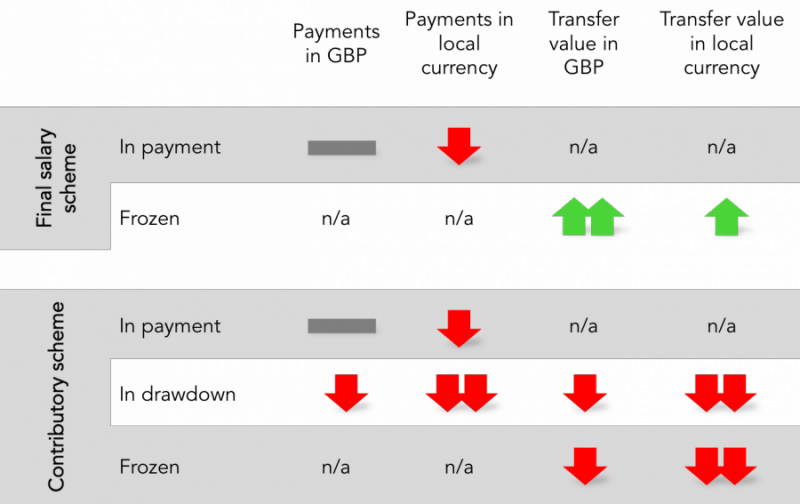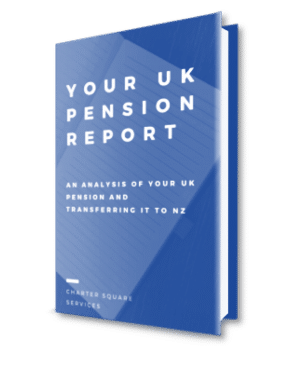There has been a lot of talk of the general implications of the Brexit vote. But what, in practical terms, is it likely to mean for those with UK pensions and those thinking about transferring their pensions out of the UK. In this article we look at each type of pension, final salary and contributory, to understand the implications for UK pension holders. So whether you have a pension in payment or a frozen pension (one that has not come into payment and you are no longer contributing to) this article should highlight for you the immediate impacts of the Brexit vote – we do warn you that some the conclusions could be counter intuitive.
INFOGRAPHIC SUMMARISING BREXIT PENSION TRANSFERS AND PENSION CONSEQUENCES
Final Salary Scheme pensions
Final Salary Schemes (or defined benefit schemes) form the largest part of the UK private pension market accounting for 80% of all schemes by assets. These pensions cover the majority of government sponsored schemes, such as the NHS and Teachers pension schemes, as well as large employers from the likes of Shell, RBS and BT down to small company schemes. Given that this is the most important group (as it is the largest) we deal with them first, please note that the minimising risk section at the end of this article is applicable to holders of final salary pensions.
So what are the impacts of the Brexit vote for holders of final salary scheme pensions:
- If your pension is in payment – the immediate impact is that you will be receiving less in your local currency if you are living outside of the UK. Indicators are that this will be a long-term movement in the pound as the UK economy adjusts to no longer being part of the single market. If it is a long-term movement you will have to get used to receiving lower payments in local currency over time. The impact of inflation from a Brexit will be a secondary smaller factor that will require assessment if your pension is inflation adjusted. With Britain importing most goods and the pound devaluing inflation could push higher (which is what inflation adjusted bond movements are foreshadowing right now), which would be a small gain to offset the loss in local currency.
- If you’re yet to receive your final salary pension – your Cash Equivalent Transfer Value (CETV) will have gone up. This may seem perverse but the value of your pension actually increases when yields on Government bonds go down. And yields have gone down due to everyone in the financial markets piling into assets that they consider safe (UK government backed bonds). Indeed the initial analysis suggests that the equivalent transfer values of all defined benefits schemes across the UK may have risen by GBP80bn the Friday after the Brexit vote. This is not all good news though. Because final salary schemes still need to have the assets to pay you the increased transfer value (and they may not have anymore due to their investment values falling following the Brexit vote.)So if you still have a final salary pension in the UK we would recommend that you review it immediately (particularly in light of the valuation issue).
Defined Contribution Pensions
These are typically personal pensions, or group personal pensions within companies. The short-term impact has been a drop in the value of the funds where they have been invested in British based companies (although there has been a subsequent dead cat bounce).
- If your UK pension is in payment because you bought an annuity – you will generally be receiving less in your local currency if you are living outside of the UK. Indicators are that this will be a long-term movement in the pound as the UK economy adjusts to no longer being part of the single market. If it is a long-term movement you will have to get used to receiving lower payments in local currency over time. You will not get any relief from an increase in inflation in the UK as the payments of the annuities are generally not linked to inflation (unless you are one of the few to have purchased an inflation linked policy). Once you have purchased an annuity with your UK pension you cannot transfer these pensions out of the UK.
- If your UK pension is in drawdown – the amount that you can take now is unlimited under flexi-access. However, if you were to set a drawdown policy based on Government Actuary Department (GAD) table results the amount that you could withdraw would be reduced due to 15 year Gilt yields falling in the UK. The value of the payments that you are receiving is going to be reduced in the currency of the country that you are living in. This is likely to continue in the future. If you were to transfer the pension out of the UK it is likely that the transfer value will have dropped due to the fall in financial markets.
- If your UK pension is frozen – the option of buying an annuity will become even less attractive as they are linked to bond yields. Bond yields are sinking and so annuity rates are following them down. The double down on this is that many funds have also dropped in value due to the financial markets movements. And the final straw is that with the currency dropping you will be in an even worse situation when payments are eventually made. There is still the option of transferring these pensions out of the UK, although the transfer values will likely be lower than pre the Brexit vote. However, that may be a small price to pay to get more certainty around the funds.
Will transfers still be allowed longer term?
At present the UK runs a liberal pension transfer regime that allows people to transfer their funds (without tax consequence) to any Qualifying Recognised Overseas Pension Scheme (QROPS). Underpinning the United Kingdom’s QROPS regime is the EU pension portability directive, which mandates the requirement for pensions to be transferred within the EU. Prior to the UK implementing the QROPS regime the pension transfer landscape was very different. The whole QROPS regime could be reviewed as a part of the 2-year Brexit plan – such a review would be done by the HMRC.
One avenue that the HMRC could easily implement would be to change the transfer rules back to the rules pre the introduction of the QROPS regime. Under this regime you needed to demonstrate that you were a tax resident of the country that the scheme you were transferring to was located.
So what can you do to minimise the risk?
If you have a frozen final salary pension you need to act now
If you have a final salary pension you need to get a review done on the pension immediately. This is so you can get a guaranteed transfer value (the guarantee last for three months) for your plan and then see if that transfer value is commensurate with the benefits that are on offer.
You can transfer to New Zealand and invest in sterling based funds
The ability to ride out exchange rates is best done from New Zealand, as once your UK pension funds are transferred to New Zealand you can decide when to convert the fund to New Zealand dollars. The problem with leaving a pension in the UK and waiting for an exchange rate – is that when it hits your desired levels you then start the pension transfer process (which takes months) and by the time the funds arrive the exchange rate could be completely different.




